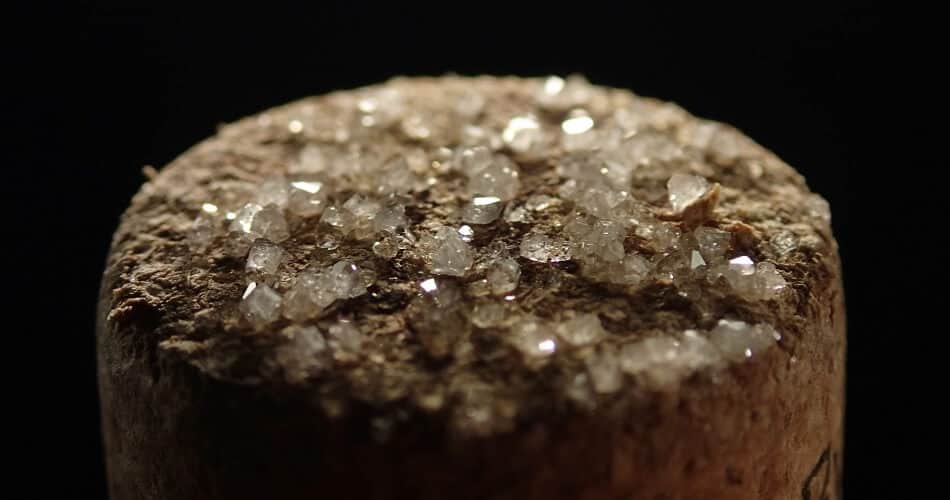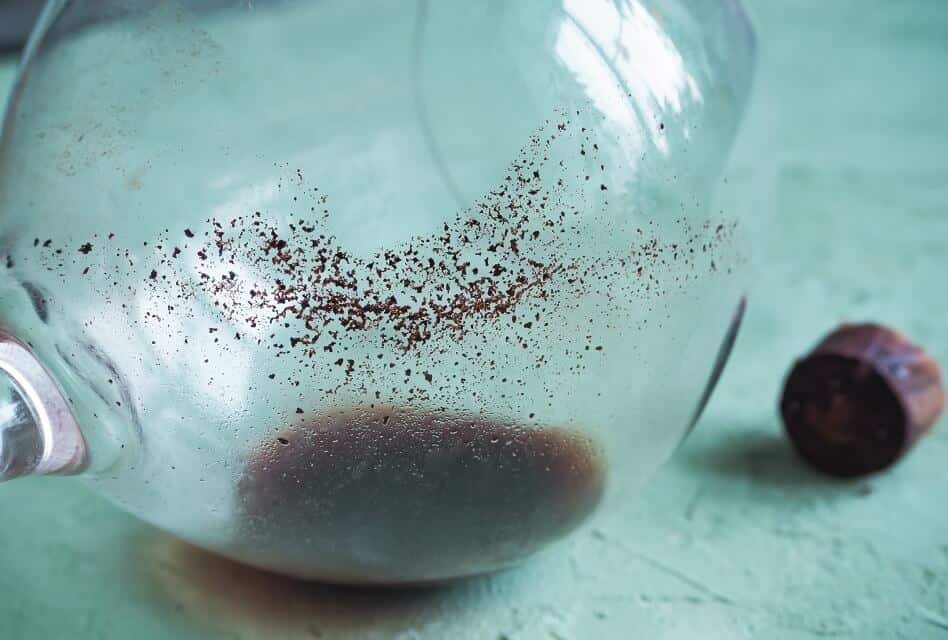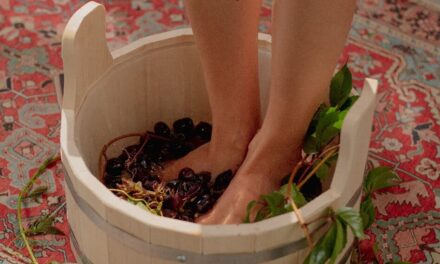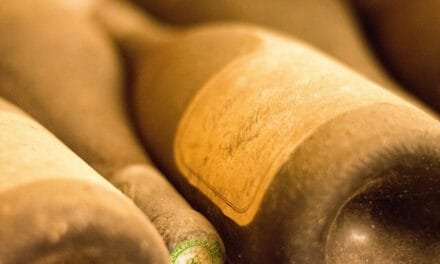Sediment in wine is a natural byproduct of the winemaking process. It can come from solid grape parts such as stems or seeds, crystallized acids, or dead yeast cells.
While many winemakers filter out particles that form during fermentation and barrel aging, sediments can also occur while storing wine in your cellar. In this case, you have to take care of it yourself after opening the bottle. This article will discuss how to do this best and whether unremoved sediments can be harmful to you.
WHAT CAUSES SEDIMENT IN WINE BOTTLES?
Sediment is a natural byproduct of winemaking. It forms during grape pressing, fermentation, or the aging process.
Sediment in wine can form early in the winemaking process. When the grapes are pressed (or stomped by feet), solid parts such as stems, seeds, or skins float in the wine must before vintners filter them out. But some particles might be so small that they stay in the wine and eventually form dark reddish-colored sediments.
The colorless sediments that look like little diamonds are formed from tartaric acids. These acids are essential in wine because they stabilize its aromas and color. Unfortunately, tartaric acids are not completely soluble, and thus, they tend to fall out as sediments, called tartrate crystals.
Another source of sediment in wine is yeast. Winemakers add it to the wine must to encourage fermentation. The yeast cells feed on the grape sugar and transform it into alcohol. But as soon as they find no more nutrients, they die. At this point, the fermentation ends. Winemakers might let the wine “mature on the lees”, giving it additional yeasty and creamy aromas, but eventually, they need to filter them out. If they miss some, the remains might form sediments.
Some vintners waive filtering wine entirely because they follow natural or vegan winemaking techniques. The resulting wines look cloudy, but they can be very good.
WHAT IS SEDIMENT IN WINE CALLED?
Sediments that come from tartrate crystals are colorless and look like tiny jewels. That is why many wine lovers refer to them as “wine diamonds”.

Tartrate Crystals on Wine Cork
Source: Francesco Santini / CC BY-SA
IS SEDIMENT IN WINE NORMAL?
Sediments in wine are perfectly normal. They occur during the winemaking process naturally. While many winemakers filter their wines to remove sediments, you still can find remains when opening the bottles. Besides, when wine ages in the bottle for a long time, additional sediments can form.
Does Sediment in Wine Mean It Is Bad?
Usually, sediment in wine is neither a flaw nor a sign of spoilage. In many cases, it is quite the opposite. Artisan winemakers handcraft their wines with much care, and they often decide to waive filtering the sediments to add more aromas and color to the wine.
But even filtered wines will form sediments if you store them in your cellar for years. While the wine ages and develops new complex aromas, some components concentrate and fall out as sediments. In this case, sediments indicate a good wine rather than a bad one.
There is only one exception: If the cork is damaged, it might crumble so that pieces of it fall into the wine. If you spot this kind of sediment in the wine, it might be a sign of spoilage. A damaged cork is not airtight anymore, so the wine can oxidize to the point where it goes off.
Is Sediment in Wine Harmful?
Sediment is not harmful, so drinking wine with sediment is okay. It will not make you sick and will not cause any health issues.
However, sediment creates a rather unpleasant gritty mouthfeel, just like drinking coffee with a bit of coffee ground would. Thus, it makes sense to remove it.
WHAT TO DO WITH SEDIMENT IN WINE?
While sediments are not harmful, they can create an unpleasant mouthfeel. Thus, removing them from the wine before drinking it makes perfect sense. To do so, you have several options:
- decanter
- meshed sieve
- cheesecloth
- coffee filters
No matter which one you use, keep the bottle standing upright for a day or two before opening it. The sediments will sink to the bottom in this position, making it easier to remove them.
Let us discuss the different options to remove wine sediments in more detail.
Removing Wine Sediments with a Decanter
Sommeliers and other wine experts use decanters to remove the sediment in wine. A decanter is a glass bottle with a wide base. It allows the wine to get in contact with air, so it can “breathe” and release its most delicate aromas. But when decanting a wine, you can also remove the sediments from it.
Pour the wine slowly from the bottle into the decanter. While doing so, monitor the neck of the bottle, ideally with a nearby light source. As soon as you see solid parts in the bottleneck, stop pouring, so the sediments cannot even leave the bottle. You might lose a bit of wine as well, but that’s the price of removing the sediments.
If some sediments make it into the decanter, do not worry. When pouring the wine into glasses, you have another chance to leave them behind.
You might want to move the wine back into the bottle after removing the sediments, for instance, because you want to take it with you when visiting friends. For this case, double decanting is the way to go: Clean the bottle properly after pouring the wine into the decanter. Then, fill the wine back in and reseal it.
Removing Wine Sediments with a Sieve
If you don’t own a decanter, you can use a meshed sieve to remove wine sediment. It isn’t the most sophisticated way, but it works if your sieve is fine enough. Especially tea strainers are good tools for this purpose, as they are made to keep fine particles out of your tea.
Again, pouring slowly is vital. And as soon as you see sediments in your sieve, you should consider stopping the pour and leaving the rest of the wine in the bottle.
Be aware that the sieve might not catch very small particles.
Removing Wine Sediments with Cheesecloth
Cheesecloth is another household item that you can use to get sediments out of your wine. Typically, it is used to make cheese (obviously), but you can also strain all kinds of liquids through it to get rid of solid particles.
Simply put the cheesecloth around the wine bottle’s opening. To be safe, use at least two layers. You can hold the cloth tight with your hand, but it’s safer to fix it with a rubber band or a piece of twine. Then, pour the wine slowly from the bottle. The cloth will slow down the process significantly, so plan some time for the procedure.
Removing Wine Sediments with Coffee Filters
Coffee filters made from paper are another option for removing sediment in wine. While their primary purpose is to keep solids out of your coffee, you can also use them to filter other liquids, including wine.
You can use the coffee filters in two different ways:
- You can place them on the wine bottle, just like the cheesecloth. Again, consider fixing it with a rubber band, then slowly pour the wine into glasses. The filter will hold the sediments in the bottle.
- Alternatively, you can put the paper filter on your glass, so it catches the sediments just before getting inside. While it works well this way, fixing the filter might be a bit more complicated, primarily if you use wine glasses with a big bowl.
In any case, use unbleached coffee filters. Bleached filters can impart very unpleasant flavors to your wine, so avoid them at all costs.
FINAL WORDS
Sediment in wine is completely normal and natural. The tiny particles are neither a sign of bad wine nor dangerous to your health. Nevertheless, you should filter them out to avoid the gritty mouthfeel they create. In any case, do not let your drinking experience be ruined by caring too much about sediments in wine. Cheers!






